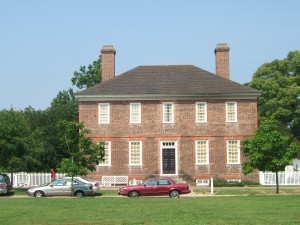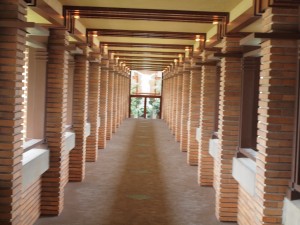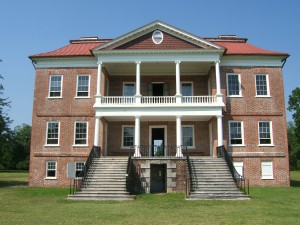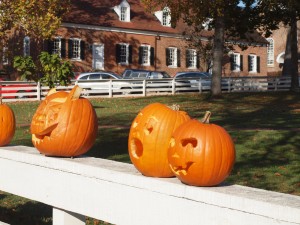Very few topics in preservation philosophy can get me riled up like “authenticity.” Everyone, especially preservationists, has a different definition of authenticity. After all, the Secretary of the interiors Standards basically define it in four different ways or levels – preservation, rehabilitation, restoration and reconstruction. With the most drastic intervention being the last, reconstruction. Those of us who have studied preservation often think about it in terms of “scrape versus anti scrape.” Very simply, “scrape” means you change sections of a building as it stands today to restore it back to an earlier time. Reconstructions and even many rehabilitations fall into the “scrape” category. “Anti-scrape” means you leave it as is, with all the changes it has acquired over the years.
Screaming for Scrape

Colonial Williamsburg – is it a preservation Disneyworld or is it an authentic approach to history? Why can’t it be both?
Is any site or project really one or the other? Not really, most projects are a combination. But I do remember that during my two years in the Columbia Historic Preservation program, many of our reading assignments and philosophical discussions revolved around scrape vs. anti-scrape. In fact, at one of the first conferences I went to in NYC, two conservators got into a screaming match because one presented her project as “anti-scrape” and the other was adamant that it was “scrape.” I remember being so horrified that two of the most well reputed professionals in the field couldn’t control themselves in public over this topic!
I used to think that I was primarily “anti-scrape” but I have learned over the 25 years of my practice, that most of what I do, and what most people do, lies within that gray area of not really one or the other. I used to point to Colonial Williamsburg as this Disneyworld of “scrape,” but the more I understand some of the treatments there, the less I say that or think that. Much of my change in thinking is probably because I’ve been living part-time for the past five years in one of the country’s best examples of restoration and reconstruction – Old Salem Museums and Gardens. And I’ve realized that what I resent mostly is not that a project is a restoration or a reconstruction, but that the story being told isn’t honest. At Old Salem, the buildings have plaques on them that identify whether they are original or reconstructions. And the overall ambiance of this still-living city is one of delight and authenticity. I can understand what the early Moravian town was, but I know that not everything I’m looking at is original.
Reconstructing a Prairie House

The reconstructed pergola at Buffalo’s Darwin D. Martin House, one of the grandest of Frank Lloyd Wright’s prairie houses.
The Darwin Martin House in Buffalo is one of the most expensive restoration/reconstructions in recent American history Frank Lloyd Wright’s grandest prairie house had several of its buildings and connecting pergola removed over the years. The project has reconstructed those removed pieces. I was totally against this for many years, but now that I live in Buffalo and often find myself there, I can understand the desire of wanting to return this place to what it was originally. I just hope that the story about its restoration and reconstruction is always told to visitors. Because it is a rich and important part of its history.
From a purely philosophical standpoint, the major concern I have with restorations and reconstructions is that no matter how many drawings and photographs you might have of a place, it is always a 2013 interpretation of that time. It can never be fully “authentic.” As architects, engineers and contractors, we make decisions about caulking to be used, brick placement or color of paint. How can it not be impacted by our twenty first century experiences? If we say it’s not, then we are deluding ourselves.
A Perfect Example of Preservation
Even Drayton Hall in Charleston, a plantation often pointed to as the “perfect example of preservation in America” has twentieth and twenty-first century interventions of some kind. No, it has not been restored back to 1780 or 1880, but left mostly as it was when the National Trust for Historic Preservation took it over in 1974. But repairs to the stairs, structural improvements to the second level floor and porticoes to keep it safe, start to muddy the preservation or “anti-scrape” waters.
Chatting About Authenticity
So, what is authenticity really? And why my sudden focus on authenticity? I witnessed this very funny exchange (funny to me!) earlier this week. I stopped at the Gift Shop of the Buffalo Historical Society (oh wait, they just rebranded themselves the Buffalo History Museum… ) to get some Valentine’s day gifts. Ok, no snark about a preservation architect buying her architectural historian fella Valentine’s gifts at the History Museum! A couple who were visiting from Pittsburgh were standing by the check out counter talking to a young man (docent or tour guide maybe), seemed like he had just given them a tour.
And the woman was very talkative. “What about Frank Lloyd Wright and Buffalo? Was he from here? I’ve seen all this stuff about him. But wasn’t he from Chicago, didn’t he create the Chicago School of Architecture?”
Young man docent, “Oh, no, he wasn’t from Buffalo but built many buildings here. Yes, he created the Chicago School of Architecture.” (ME: No, he had nothing to do with the Chicago School of Architecture.)
Visiting Pittsburgh Lady, “How many buildings did he build here?”
Young man docent, “I don’t know but there are the Martin House, Graycliff.”
Visiting Pittsburgh Lady, “Oh yes, the Martin House, we drove by it. We live near Fallingwater. Now at Fallingwater they always talk about ‘authenticity.’ Is the Martin House Authentic? Is the restoration finished?”
Young man docent, “Oh yes, it’s very authentic. (Me: About 1/3 of the complex is a reconstruction. Is that authentic?) They’ve been restoring it for about 5 years and now they’re done (Me: No, they’re not, they still have at least 2 years to go). I had a tour of it several years ago by the Director and she told us they’d spent about $120,000 so far!!! (ME: Well, as of two months ago they’re up to $50M and I wouldn’t be surprised if it will hit $75M ultimately).
Visiting Pittsburg Lady, “Wow, that’s a lot of money.” (Me: What would she say if I corrected him and told them the real cost?)

The Darwin Martin House Garage, now the Gift Shop – can you tell if this building is original or reconstructed?
The conversation continued in like manner, moving onto whether electricity had been invented in Buffalo and a discussion regarding the Theodore Roosevelt Inaugural National Historic Site downtown and how it was owned and run by the National Trust for Historic Preservation (ME: No, that’s the National Park Service). It took all my power not to interject continually and correct them both.
So, I guess it’s good that people are attempting to have history discussions. Does it matter that about 75% of their discussion was either partially incorrect or wholly incorrect? Maybe not. I did find it quite amusing that two people who had absolutely no idea what “authenticity” actually meant were trying to have a discussion on authenticity. Although I guess “trying” is incorrect. As far as they knew they were having a very informed discussion about authenticity!
And if you’d like to “subscribe” or follow my blog, True Green Cities, please sign up through the “Subscribe” button at the bottom left of this page. You’ll receive a daily recap when new blogs are posted. Or Sign up for the Feed in the top right.



